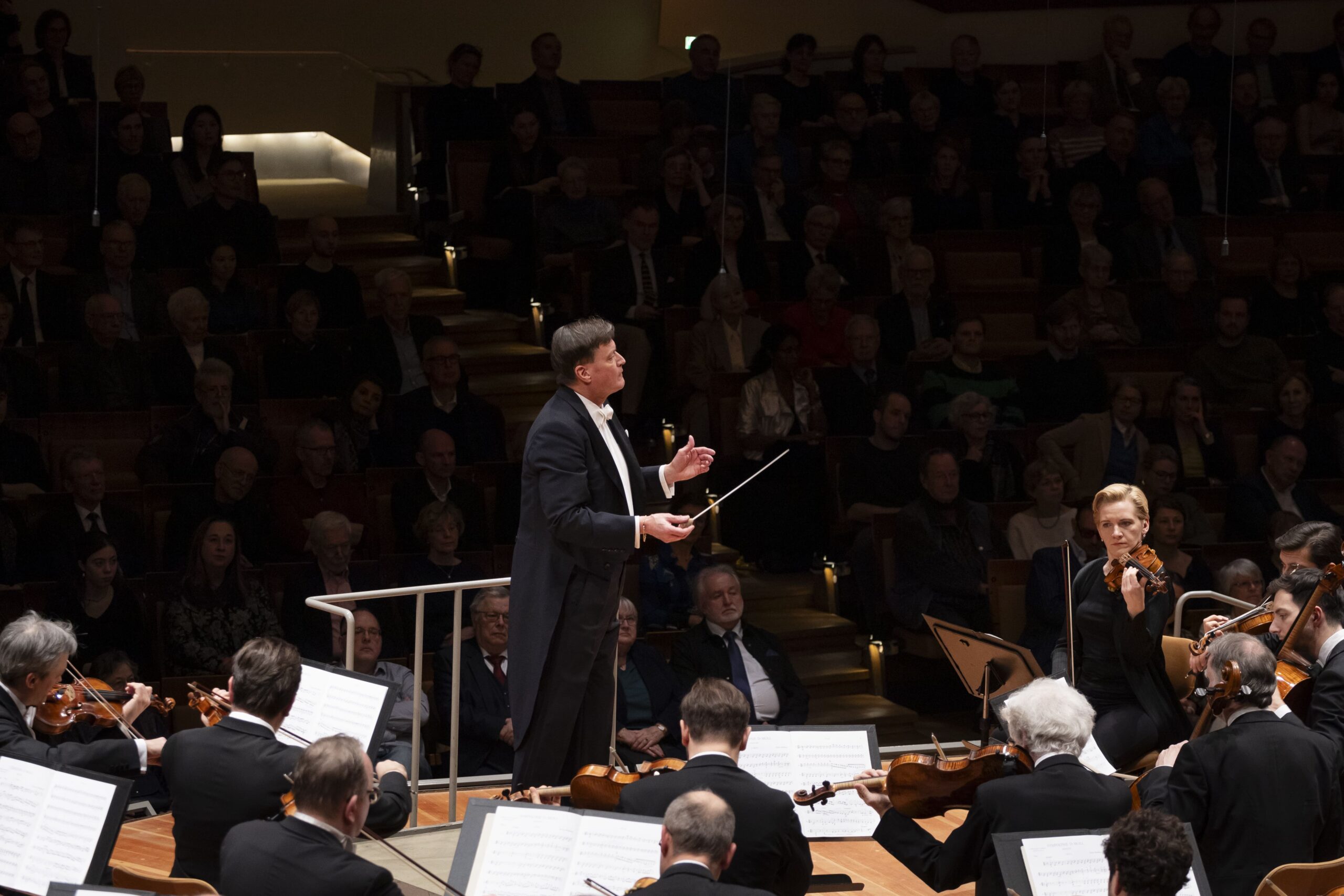“It sounds like Bruckner, but it’s hard to believe it’s Bruckner. And yet, it is! We always perceive that Bruckner is on his way.” (Christian Thielemann, on Bruckner’s Symphony in F minor)
In this Bruckner year, it is a delight to hear the composer’s two “youth” symphonies under the baton of Christian Thielemann, still basking in the success of his complete recordings with the Vienna Philharmonic, now conducting the Berlin Philharmonic.
Before delving into the concert’s details, it’s good to briefly recall the relationship between Bruckner and this prestigious ensemble. When the Berlin Philharmonic was founded in 1882, Bruckner was on the verge of achieving total triumph with his Seventh Symphony two years later, establishing his reputation as a major symphonic composer. However, this emerging orchestra paid little attention to him, favoring anti-Bruckner figures like Brahms, under the influence of conductors such as Joseph Joachim and Hans von Bülow. It wasn’t until January 1887 that the orchestra played a work by Bruckner, which was lukewarmly received by the audience and press. Everything changed with Arthur Nikisch’s arrival in 1895, a fervent admirer of Bruckner, who regularly conducted his works. After Nikisch’s death, Wilhelm Furtwängler took over, and his interpretations helped reveal the transcendental and tragic dimension of Bruckner’s music. With other conductors in the 1920s, like the underrated Felix Maria Gatz, Bruckner’s music gained popularity. At the Philharmonic’s 50th anniversary in 1932, Bruckner’s work was firmly established in their repertoire. Later, Herbert von Karajan, Claudio Abbado, and Sir Simon Rattle each contributed to the evolution of interpretations of the Master of St. Florian’s work, and Gunter Wand achieved an almost complete high-quality cycle, enriching the repertoire with varied performances, as evidenced by a recent edition of his nine symphonies conducted by nine different conductors. Bruckner, Berlin, Thielemann, a winning trio?

A Fresh and Inspired Symphony in F minor (“00”)
In 1895, just a year before his death, Bruckner undertook a methodical inventory of his musical work. He reorganized his compositions, setting aside some pieces, including a symphony in D minor he wrote in 1869 upon his arrival in Vienna. Bruckner was critical of this work, as evidenced by his handwritten annotations like “ungiltig” (“invalid”), “annulirt” (“canceled”), and “ganz nichtig” (“totally null”). Rejected by the composer himself, this symphony was designated as number 0 and nicknamed “Die Nullte.” However, the “Nullte” is actually… his third symphony! Three years earlier, he had composed his Symphony No. 1 in C minor (1866, Linz), and even earlier, a study symphony in F minor (1863). To correct the chronological sequence, musicologists decided to assign the study symphony the number 00, or “double zero.” The piece, deemed “uninspired” by Otto Kitzler, Bruckner’s mentor and patron, joined the list of the composer’s somewhat neglected works, acquiring an appellation reminiscent of a secret agent. It would be futile to forcibly find genius in this study symphony: it was indeed a trial, a kind of draft, and Bruckner hardly put any dynamic or phrasing indications. He would certainly have opposed the exhumation of this simple trial (which exceeds 45 minutes!), which occurred during the centenary of his birth in 1924, along with the Symphony No. 0. It’s not surprising that great Bruckner conductors showed little interest in this symphony.
Yet, tonight, Christian Thielemann, one of the great celebrants of this composer, achieves the feat of keeping the audience captivated from beginning to end, not least by his sense of rubato, his elegance, the attention paid to the sections, the desire to reveal the musical laboratory that is this piece. Conducting without a score, the conductor seduces with his desire to aerate, to make the orchestra “sing,” without imposing himself (indeed, he is often in the background, using very economical gestures). He plays the card of freshness and vivacity from the first movement (Allegro molto vivace), with the remarkable cello of Laurent Delepelaire. This quality of song, like a gushing spring, often reminds one of Mendelssohn, particularly the Scottish Symphony, there’s something indefinable, that seems to have the maritime color of the Hebrides. The second movement (Andante molto) has more Schubertian hues, clearly melancholic, with beautiful arabesques of clarinets and flutes. The filiation with Schubert’s Ninth seems evident, especially in the treatment of the winds, the magnificence of the oboe, always impeccable in Berlin. Despite some awkward writing and certain lengths, this movement is very well executed by Thielemann, with exemplary sobriety: he relies on the musicians’ virtuosity and the dreamy pianissimos offered tonight by the Orchestra. Undoubtedly, the Scherzo appears as the most “Brucknerian” movement of this study symphony, with its obsessive repetitions, its sardonic tonality, the powerful reexposition of the first motif, after real, peaceful poetic moments, still very Mendelssohnian. The Finale, Allegro, owes much to Schumann this time, with its abrupt contrasts, sometimes haphazard inspiration: very dance-like, Thielemann’s enlightened direction makes perfect sense here. The conductor manages to make this music captivating, with its wanderings and fugues. Sometimes, it feels like the “Rhenish” Symphony, with its mythological evocations and deliciously Sturm und Drang tonality, very inspired horns, and an accelerando with great effect at the coda, brilliant final measures that seem to come directly from some fantastic Berliozian vision. A true moment of happiness to hear this Symphony “00” played with such sound luxury and the setting of the Philharmonie!

A Symphony No. 0 in D minor (“Nullte”), nuanced, powerful, and poetic
There are similarities between Symphony No. 0 and Symphony No. 3 of Bruckner: the opening measures resemble each other and both use an ostinato for the codas. In 1895, as Bruckner moved to more modest accommodations in a wing of the Belvedere Palace, he rediscovered the score of this symphony written about 25 years earlier. He did not destroy it, and besides the derogatory mentions we recalled earlier, he wrote the symbol “zero” (Ø) three times, earning it the nickname Symphony “Die Nullte.” Its first performance took place 28 years after Bruckner’s death. The last two movements were premiered in May, and the complete work on October 12, 1924, a day after the composer’s death anniversary.
From the first measures, we indeed hear a Bruckner symphony, without a shadow of a doubt, with that motility and momentum reminiscent of the beginning of Symphony No. 1, itself a kind of extension of Schubert’s Ninth. Using quite ample tempos for this Allegro, Thielemann is very subtle, light, airy. He takes his time, as if intoxicated by the orchestra’s sound beauty. Indeed, we hear pure moments of poetry with these dialogues between bassoon, oboe, and violins. The conductor succeeds in combining power, dynamism, and gentleness, particularly in the most brass-heavy passages (remarkable horn section). Thielemann captures the “floating” aspect of the Upper Austrian landscapes encountered in later symphonies: pianissimo sound waves. He has a real sense of nuance, far surpassing the pioneering yet honorable interpretations of Inbal or Tintner, who did not enjoy the same orchestral excellence. His gestures are meticulous, he is fully devoted to this music, serving it with faith and commitment. The second movement (Andante) may not have the emotional power of the later Adagios, but Thielemann compensates for the relative weakness of the work’s writing with remarkable interpretative intelligence: he relies once again on the orchestra, sovereign in nuances and silences, a miraculously transparent oboe, remarkable strings. This movement is noteworthy for the virtuosity of the Berliners, the added sound value, the desire to show, without heaviness, the slow emergence of the mature Brucknerian style, with echoes of Mendelssohn’s Reformation and reminiscences of Bach chorales. The end is infinitely tender. The Scherzo (Presto) marks an incredible, abrupt contrast, very close in spirit to that of the Third Symphony. Thielemann stands out with vigor and strength, expressiveness that gives this movement a mocking, macabre, sometimes Dantean dimension. It’s striking to see how he relies on the violins, his left hand almost touching the strings. The last movement is perhaps the most Wagnerian of all (Tannhäuser!), and we are seduced by the contrasts, tempos. The maestro sometimes stands back on the podium, letting the orchestra take the initiative, while extending the serene, almost pastoral spirit of the second movement. The triumphant, luminous coda concludes the symphony in a very bright major key, rather than in D minor. It elicits sustained applause and a very well-deserved success for Christian Thielemann and this revelation of two little-known symphonies that should appear more often in the repertoire.
Philippe Rosset
February 29, 2024
https://www.berliner-philharmoniker.de/konzerte/kalender/details/55060/






